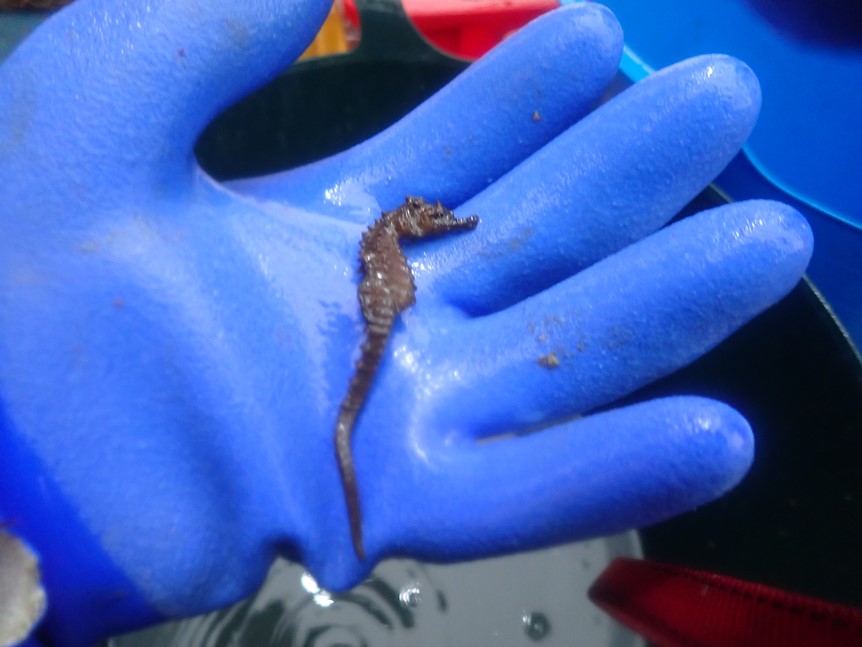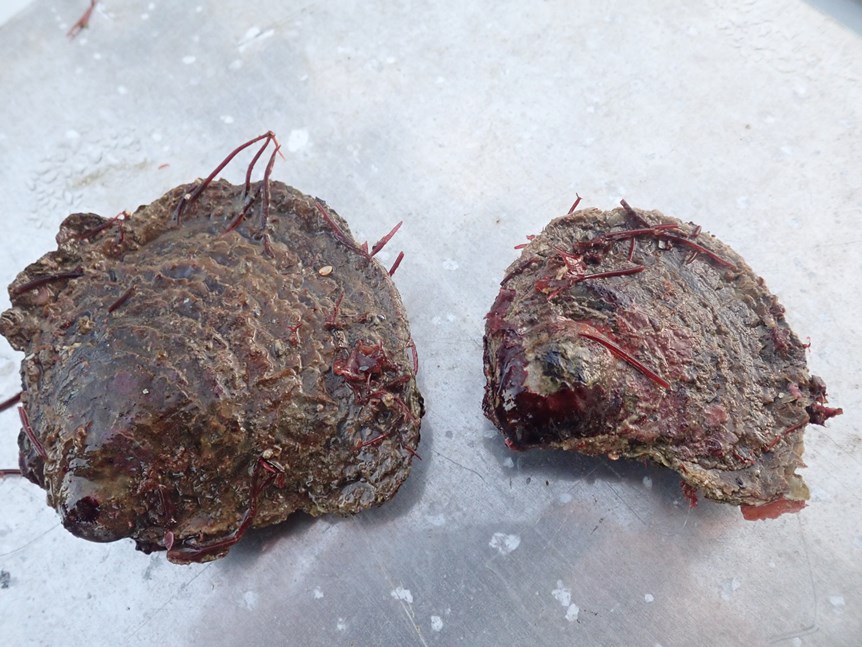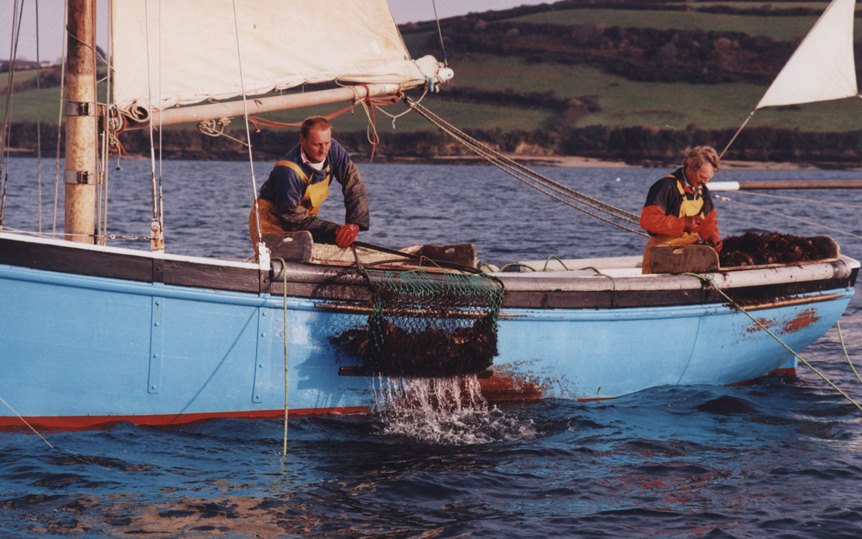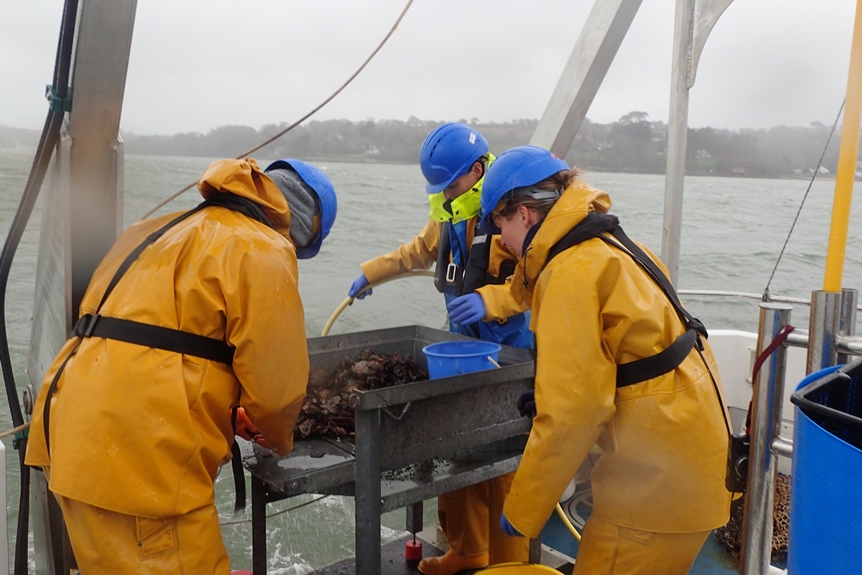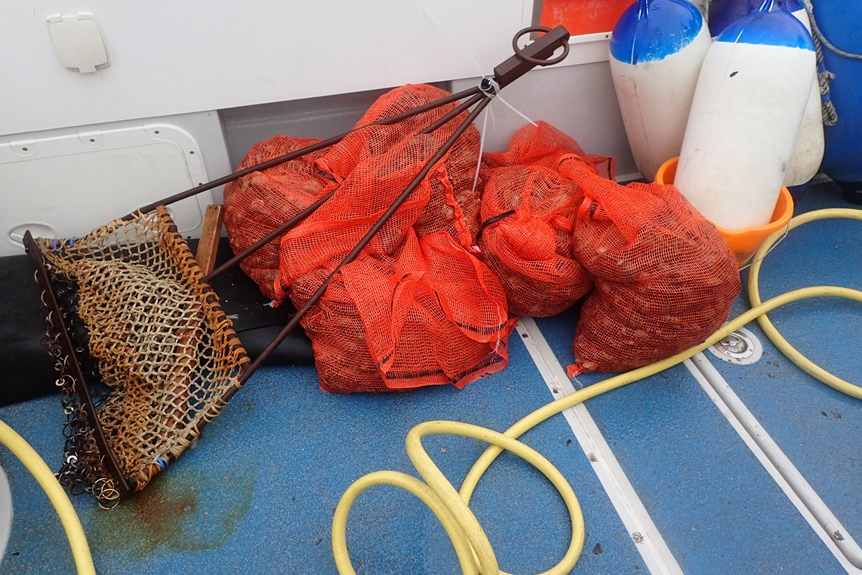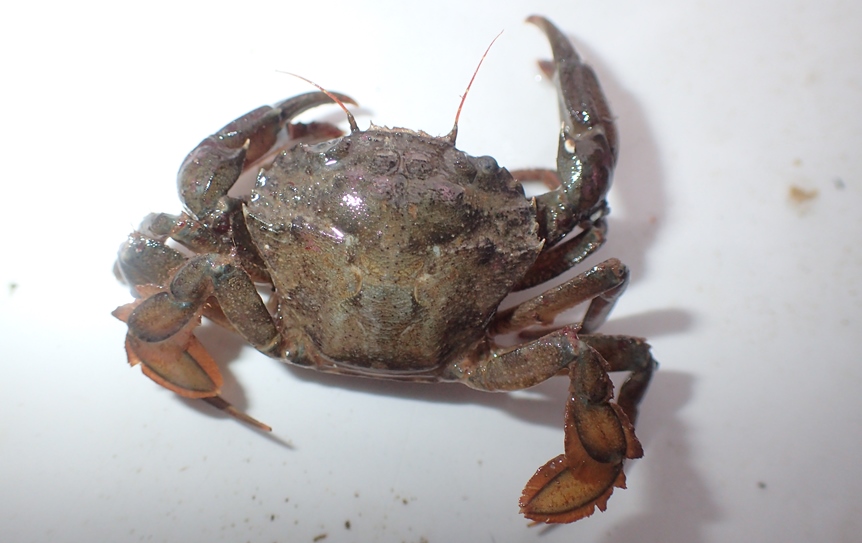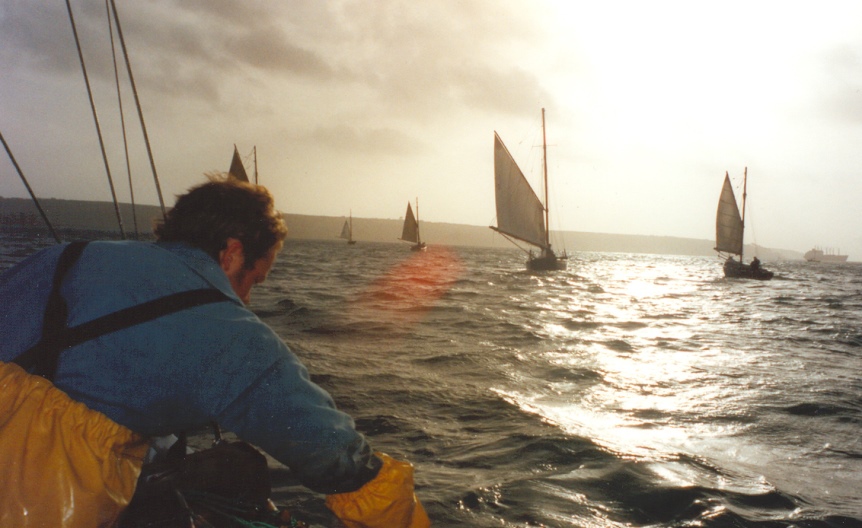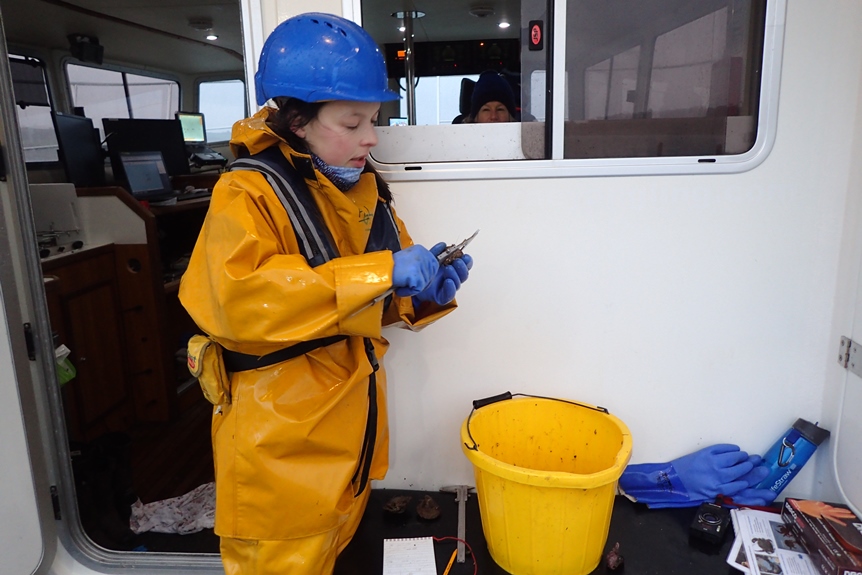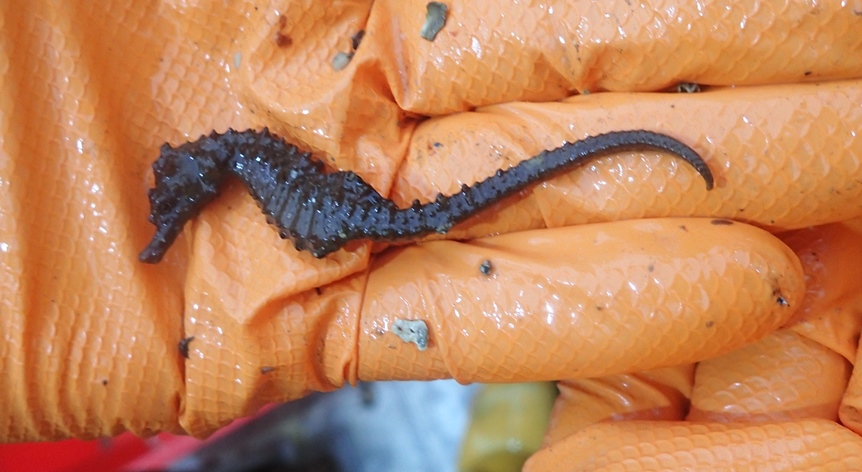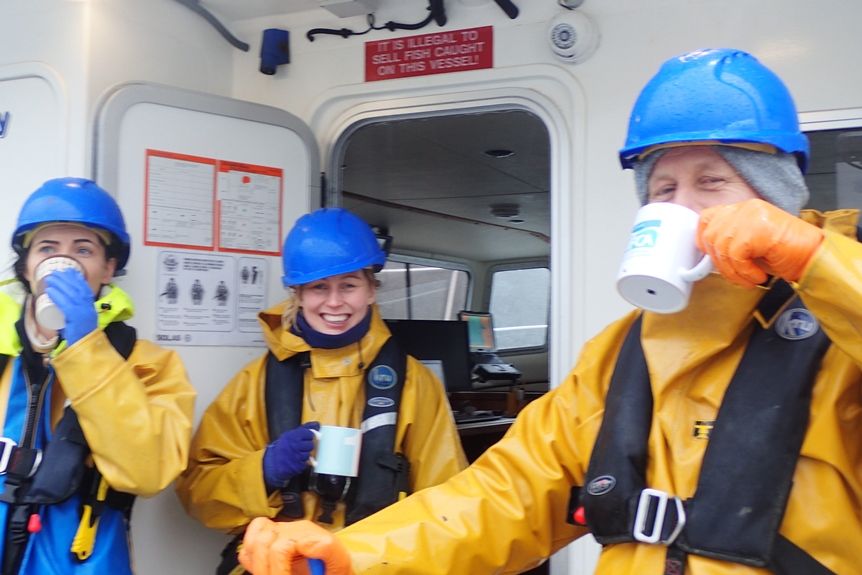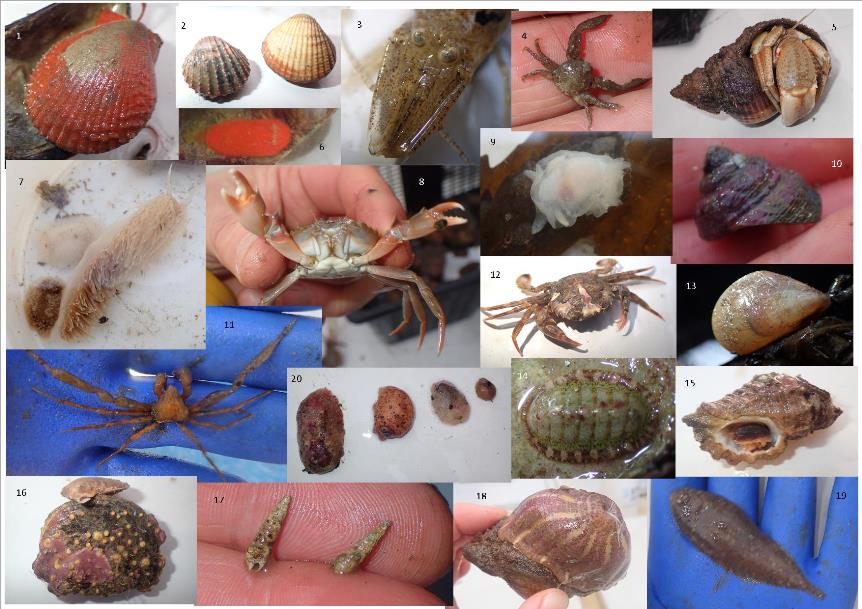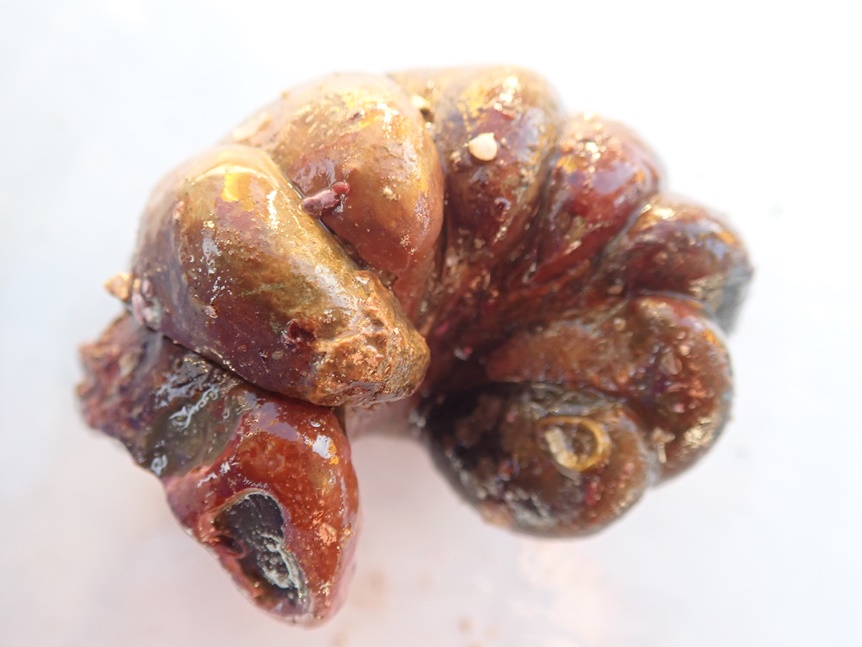It was a dark winters morning, and Cornwall was being lashed by a strong easterly gale. With the sky dark and rain falling horizontally I was not sure what to expect from the day I had signed up to, helping out with a survey of the Fal oyster fishery aboard the Cornwall IFCA research vessel the Tiger Lily VI.
I got handed a lifejacket and a hard hat and I was glad I had brought extra thermals and my full oil skins! Shortly the first tow of the day was underway. Skipper Chris Lowe looked quite happy in his warm dry cabin as the team of marine scientists, led by principle marine scientist Colin Trundle, and I waited out on the deck in the rain for the first dredge of the day to come aboard.
I joined the team on the last day of their annual four day survey which assesses the health of the shellfish stocks and wider environment within the Fal oyster fishery area. This is my home patch having grown up as a “harbour rat” on the Fal and having spent many hours aboard the oyster boats as a boy and young man, both fishing and racing, the fishery is very important to me on many levels.
Fig 1; Native oysters Ostrea edulis, Photo Cornwall IFCA.
The flooded valley of the Truro River creates a unique wide estuary, known as a ria, which has highly productive sub-tidal gravel and shell banks, home to the native oysters, which have been harvested for centuries in a traditional, sustainable fishery. The beauty of the Fal oyster (and queen scallop) fishery is the fact that it was effectively frozen in time by forward thinking managers who, in 1936, banned the use of engines or any other power source except sail, oar and human muscle; The result has been the continuation of a traditional fishery and a way of life, the only fishery of its kind in Europe. While many other native oyster fisheries around Europe have collapsed, the Fal fishery has remained viable and has a bright future.
Figure 2; Oyster fishing under sail. Photo by Phil Lockley
The weather was so foul I noticed that none of the sail boats were joining the fishing that day. Just as well as the fishers aboard the traditional gaff rigged sail powered ‘working boats’ used have none of the luxuries we did aboard the Tiger Lily, with its well-appointed cabin and galley! The estuary is relatively sheltered from the prevailing south westerly’s but a south or south east wind funnels straight into the Carrick Roads, and when it gets strong it seriously hampers fishing as sailing becomes dangerous. The wind whistled around the boat as the anchor was drawn in, pulling the boat forwards and the dredge along the seabed. Fortunately our crew were afforded some shelter as the boat naturally pointed into the wind. Something the sail boats can’t do as they have to drift downwind while pulling their dredges.
Figure 3; Oyster survey on Cornwall IFCA research Vessel Tiger Lilly VI, Photo Matt Slater
Oystermen have to manually haul their dredges up to empty them, but we were lucky having a beautifully designed hydraulic system aboard the survey vessel. The dredge itself however was exactly the same size and design as those used by the oyster fishermen. It’s a lightweight metal frame of a maximum 0.72metres wide with a steel, untoothed blade (front edge) and a lightweight chain mail belly. The dredges have to be light (under 20 kg) or a man couldn’t pull them all day long. They don’t dig into the sea bed but skid along the surface, picking up empty shells and small stones, what’s known as the ‘cultch’, among which the oysters are found.
Figure 4; Oyster Dredge used for survey and bags of slipper limpets, Photo Matt Slater
Straight away, like a well-oiled machine, the marine scientists aboard sorted through the catch, collecting up oysters, queen scallops and slipper limpets from the mass of purple coralline algae covered shells and seaweeds. Scuttling among the shells were a multitude of small crabs including several beautiful navigator crabs, these are fast moving members of the swimming crab family, they are abundant on the Fal oyster beds but a species that I only recently correctly identified.
Figure 5; Navigator crab, Liocarcinus arcuatus, Photo Matt Slater
As the survey took place, I was transported back in time…. For a winter I worked as an oysterman back in the mid 1990’s aboard the Six Brothers skippered by Marshall Vinnicombe, a legendary oyster man. Back then I was younger and fitter but still didn’t stand a chance of keeping up with Marshall who despite his years (nearly twice mine at the time) was frighteningly fast at sorting the catch and picking out oysters which would hang- that is oysters that are above minimum landing size being able to “hang” within the circle of an oyster gauge, 67mm in diameter.
Figure 6; The author oyster fishing in '97, Photo Phil Slater
The work was hard and I was a hopeless fisherman as I was constantly distracted by the incredible diversity of species that can be found coming up with each dredge. It’s astounding how many weird and wonderful creatures can be found living on and in the cultch.
Many years later and having developed a greater understanding of marine species identification I am now much better equipped to name the creatures I find but, as expected there are still many species that are hard to identify and I found myself dashing for the books surprisingly often!
While the Cornwall IFCA staff measured and counted the numbers of oysters, queen scallops and slipper limpets, I got stuck into identifying tiny creatures, crabs, seaslugs, small fish, anemones and a huge range of seaweeds all come up in the dredges. Sat in the shelter of the cabin Annie was frantically typing the numbers into a spreadsheet on her laptop while the other Science Officers using callipers measured the size of each oyster and scallop and counted every slipper limpet.
Figure 7; Stephanie measures oysters while Annie inputs the data, Photo Matt Slater
A total of 83 sites are sampled each year during the Cornwall IFCA Fal Oyster survey. The sites are arranged in a logical grid pattern that covers the whole of the fishery which starts at the line between Trefusis Point near Flushing east to a point on the shore near St Just In Roseland, and extends north into the Truro river going right up as far as Malpas, not far from the City of Truro itself.
At each survey point a 50 meter tow is carried out and the survey vessel is used much like a traditional haul tow (oar and winch powered) punt. An anchor is deployed and the boat reverses downwind, running out its anchor cable. The dredge is then deployed and it sits on the seabed. The anchor chain is then hauled in and the dredge is towed 50 meters along the seabed at a good steady slow pace. The dredge is then hauled up and emptied at the back of the research vessel. Start and finish points are recorded by the skipper and the hauls are thus replicated exactly each year.
A few hauls in I was starting to get into the swing of the day, the sun came out and the wind started to die back a bit. It was still too rough for the sail boats though. Leader of the survey, Colin Trundle came to the stern to check on the progress of the survey. I wondered to myself if they had found anything really exiting that week and whether we would come up with any interesting fish in the dredges, I was about to ask Colin this question when an excited shout echoed out ‘Seahorse!!’
Figure 8; Short snouted sea horse, Photo Matt Slater
Among the oysters, sea lettuce and shells that had been emptied onto the survey tray at the back of the boat was a beautiful short snouted seahorse. Colin gently placed it into the seawater of my specimen bucket. I had heard rumours that occasionally oystermen found seahorses in the Fal, however I really didn’t expect to see one on this day!
I picked it up gently to take some photos and the sun glinted off the amazing armour plated spines that protect its body. Seahorses are magical looking creatures, with bizarre features that confused early biologists. They have a long prehensile tail like a monkey. They have rotating eyes like a chameleon which can move independently. Male seahorses have a pouch like a kangaroo. The surprising thing is that they are actually fish, related to pipefish!
The species found was a short snouted seahorse, Hippocampus hippocampus. The last known record of this species in Cornwall was found by a crab potter Daniel Gilbert who caught one in a crab pot off Newquay in 2012.
The seahorse we found was perfect, a female adult and approximately 13cm in length. After a few photos had been taken we did a quick health check and then it was returned to the water in the same position that the dredge had been pulled up.
There was a tangible feeling of excitment aboard the Tiger Lily that day! Everyone loves a seahorse and it was such a privilege to have seen one! Seahorse are rarely recorded in Cornish waters, divers rarely see them as they are so well camouflaged. They require a healthy environment, clean water and plentiful tiny shrimps to eat. The fact that we had found a healthy adult female in the estuary suggests that the estuary is in a good condition of health.
Figure 9; Well deserved tea break, Photo Matt Slater
For the rest of the day this view was added to as each haul yielded a healthy diversity of species; relatively good numbers of oysters, lots of queen scallops, and relatively low numbers of the non-native slipper limpet. A wealth of other bycatch was recorded including six different species of sea slug, including: sea lemons, sheep sea slug, sea hares and many more!
Figure 10; Compilation of just a few species found during the surveys Photos by Matt Slater and Cornwall IFCA.
1 Queen scallop encrusted with orange sponge. 2; Spiny cockle. 3; Brown Shrimp. 4; Long clawed porcelain crab. 5; Common hermit crab (large!). 6; Nudibranch Rostanga rubra. 7:Sheep sea slug and two other species. 8; harbour crab. 9; Nudibranch, Gonidoris nodosa. 10; Turban top shell. 11; scorpion spider crab. 12; Flying crab, Liocarcinus holsatus. 13; juvenile mussel. 14; Chiton. 15; Oyster drill or Tinkle whelk. 16; Shell colonised by boring sponge, Cliona cellata. 17; Tiny shells, Bittium reticulatum. 18; Parasitic anemone. 19; Sole, juvenile. 20; Collection of sea lemons.
Figure 11; Slipper limpet chain, Crepidula fornicata, Photo Cornwall IFCA.
Several different species of bivalve (clam like) molluscs were found including spiny cockles and otter shells. Interesting sponges including the boring sponge (which uses acid to bore into old oyster shells, and the sea fig were found. Strange, leathery, Korean sea quirts were found but fortunately they were relatively rare. This species is a non-native that is thought to have been brought to the Fal in ballast water from shipping in the 1940’s.
Another non-native that was notably rare on the oyster beds was the pacific oyster. This was surprising to me as the numbers of these has exploded all around the edges of the estuary in the last few years. Unlike the native oyster which prefers permanently water-covered (subtidal) oyster beds the Pacific appears to thrive best on the shore (intertidal), often in the largest densities when attached to barnacle-covered rocks. The recent population explosion of Pacific oysters may be down to the effects of climate change and the oysters themselves becoming gradually adapted to lower temperatures. Pacific oysters have been farmed in the Fal and other estuaries for years but it is only in the past few years that the feral population has raged out of control in this way. One fear is that they have the potential to totally change the marine environments in which they live by eventually smothering all other species and creating reefs of oysters. These reefs are extremely sharp, and if they begin to form on soft ground they could eventually take over the native oyster beds. It was great news that during the survey no Pacific oysters were found on the oyster beds. The oyster fishers and Cornwall IFCA will no doubt need to be vigilant to prevent this species taking over in future. A two year project coordinated by Natural England and locally led by Cornwall Wildlife Trust is training volunteers to record pacific oyster numbers and also trialling culling of these non-natives to find out if this is an effective management solution. Populations are now being controlled in the Helford Estuary, Mounts Bay, Looe harbour and Whitsand bay but large populations are still present in the Fal, Fowey and Tamar Estuaries but volunteers are mobilising to attempt to control these.
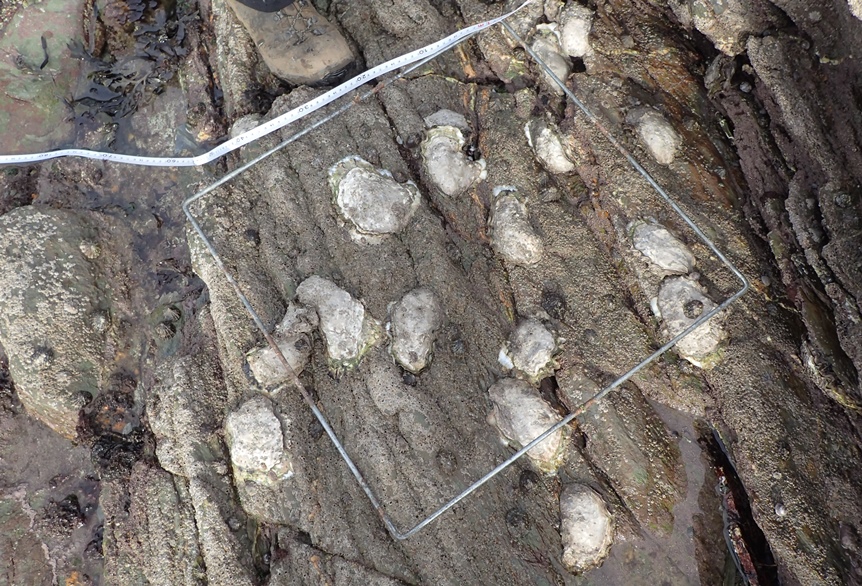
Fig 12; Pacific oysters found on the shore at Messack Point in large numbers on a Shoresearch Cornwall survey 2019, Photo Matt Slater
A surprise to me was the incredible quantity of
queen scallops that were caught in each dredge. This species has long been found on the oyster beds – oysterman Timmy Vinnicombe has been eating them for years , but it was only a couple of years ago that they were classified as suitable for human consumption and a market was opened up for them. These small scallops are actually a different species to the queens that are harvested in the Irish sea and other offshore areas. They are actually variegated scallops Mimachlamys varia, they differ in that they produce byssus threads, sticky threads similar to those that mussels produce to anchor them to rocks and shells on the sea bed. They are also often covered in bright orange encrusting sponge giving them a really bright appearance. Inside the shells there is less meat than in a larger king scallop but it is delicious and of course they are harvested using the same very low-impact, traditional method used to collect Fal oysters, so a great alternative to dredge caught king scallops. My feeling is that their name is misleading and as they are a different species maybe they should be re-branded as Fal scallops or something else more imaginative… princess scallops perhaps?
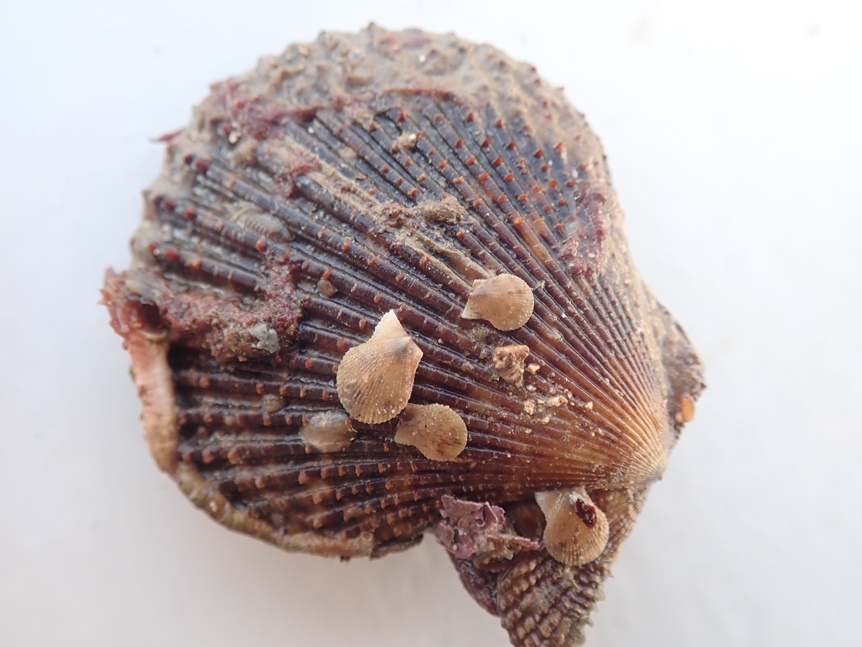
Figure 13 Queen, or variagated scallop Mimachlamys varia with tiny juveniles also attached
This incredible estuary is buzzing with life, its future is in good hands with the thorough monitoring and management of Cornwall IFCA and the experience and expertise of the oyster fishers themselves. With more changes likely in coming years thanks to the effects of climate change and the unpredictable effects of non-native species it is great that this fishery is being so looked after.
I recommend locals and visitors to Cornwall alike to support sustainable Cornish fisheries by eating more local sustainable seafood. Fal oysters and queen scallops are great examples of local sustainable seafood but there are many more listed on our informative website Cornwall Good Seafood Guide.
www.cornwallgoodseafoodguide.org.uk
Article written by Matt Slater, Cornwall Good Seafood Guide.

